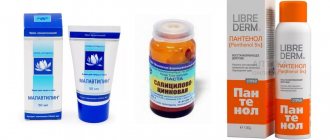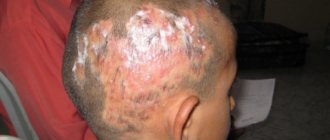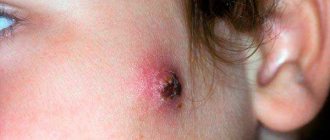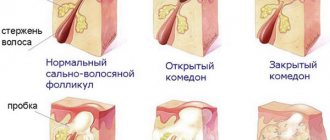Pimples on the pubis with heat rash
The most common cause of this unpleasant symptom is prickly heat. This specific disease is characterized by damage to the sebaceous and sweat glands. The main cause of the problem is the creation of a “sauna effect” under too thick or synthetic clothing. In the absence of air circulation, the liquid from the surface of the epidermis does not evaporate, and overheating occurs.
Pimples on the pubis in men with exacerbation of prickly heat often appear when it is necessary to wear a strict suit or tight robe in the hot season. The problem is equally relevant for office clerks, welders, loaders and drivers who are in a static position all day long. The main symptoms indicating damage to the skin pores:
- small rashes on the pubis, inner thighs, around the anus;
- the rash is itchy and very itchy;
- the epidermis looks irritated, there is redness;
- slight swelling is observed;
- the lymph nodes in the groin are enlarged.
Miliaria is not an allergic reaction. It occurs more often in men who are overweight, have diabetes, or have skin diseases. Increased sweating, causing an itchy rash, occurs in stressful situations, during intense training. A negative skin reaction occurs when taking certain medications.
Treatment for prickly heat involves maintaining personal hygiene. Pimples on the pubic area can be cauterized several times a day with a solution of Chlorhexidine, tincture of propolis or calendula. They dry the skin a little and eliminate inflammation when bacteria enter. To prevent itching from distracting you from work, it is recommended to take antihistamines: Loratadine, Claritin, Fenistil.
Preventing prickly heat is much easier than treating it. When working in hot conditions, you should use underwear made of natural cotton and linen, and remember to drink properly. For bathing, it is better to use tar or baby soap with extracts of St. John's wort, chamomile, and string. After treatment with deodorant, all areas with increased sweating are sprinkled with talcum powder or special body powder. It absorbs excess moisture and prevents irritation.
Candidiasis in the groin
One of the signs of candidiasis infection is pubic acne in men. The causative agents of the disease are yeasts, which are very common and are considered part of the natural microflora of any person. They are present on the mucous membranes, tongue, and intestines. A healthy immune system prevents their reproduction, but a history of acute respiratory viral infection, flu or stress triggers the inflammatory process. The symptoms are difficult to confuse with other types of mycosis:
- the rash is filled with clear exudate;
- pimples are localized in the groin, folds between the legs;
- the skin is painfully itchy;
- the epidermis on the pubis takes on a bright red tint.
A man begins to scratch the rash, which can cause an infection. This leads to non-healing wounds, the formation of ulcers and exacerbation of the disease. A whitish coating is observed in the inguinal folds, under which cracks remain on the skin. Depending on the symptoms, one of the forms of candidiasis in the groin is diagnosed:
- Vesicular : areas of erosion occur, and the rash often becomes purulent. The redness is accompanied by peeling.
- Erymatous : the rashes are combined into bluish or brown spots covered with a white film of plaque.
Candidiasis in the intimate area threatens a man with infection of the penis and head, spreading to the urethra and bladder. Therefore, treatment should begin when the first signs of a rash appear on the pubic area. Effectively treat the groin with antifungal drugs. Thick ointments are gently rubbed into the epidermis, lubricating all reddened areas. Most often, dermatologists recommend:
Folds and pimples on the pubic area are wiped twice a day with a solution of Nystatin or Candida. To speed up the healing of erosions, which often remain after rubbing with linen, the wounds are lubricated with sulfur or salicylic ointment. If the disease has led to balanoposthitis, a rash has appeared on the genitals, it is necessary to take a course of antimycotics in tablets: Terbinafine, Levorin, Nystatin, Orungal.
Rashes due to syphilis
The appearance of a rash on the pubic area sometimes becomes a symptom of such a common sexually transmitted disease as syphilis. Small pimples form in the second stage and indicate damage to the man’s lymphatic system. Previously, a large boil appears on the skin, which breaks through, leaving a painful ulcer. The following symptoms are diagnosed 3–4 weeks after infection:
- the man loses his appetite;
- there is aching in the joints;
- a papular rash covers the pubis and spreads to other parts of the body;
- lymph nodes can be easily palpated.
Syphilis is a dangerous disease and therefore requires long-term treatment under the strict supervision of a venereologist. A whole range of drugs is used that act on the pathogen and destroy inflammation in bone tissue. The specialist must monitor the patient constantly in order to adjust doses and include immunostimulants and antiviral agents in therapy.
Pubic rash due to dermatitis
Increasingly, men are turning to a dermatologist who have a small rash with red edges on their pubic area. This is how dermatitis, a disease of an allergic nature, can manifest itself. It occurs with constant exposure to irritants:
- hard work;
- family stress;
- lack of personal hygiene;
- use of detergents with a large number of dyes and fragrances;
- uncontrolled use of hormonal drugs.
Dermatitis and pimples on the pubic area are often caused by shaving the groin area. Irritation turns into inflammation, causing painful burning and itching. It can be complicated by a fungal or bacterial infection, suppuration in bursting papules. Treatment is carried out using external creams:
The components in their composition relieve redness, soothe the epidermis, and heal minor wounds. For an oozing rash, it is better to use salicylic-zinc ointment and wipe with a swab dipped in hydrogen peroxide. Depending on the cause, the doctor recommends that some men take drugs to reduce the excitability of the nervous system, plant-based antipsychotics. For seborrheic dermatitis, treatment includes antiallergic drugs, physiotherapy, UHF and ozokerite compresses on inflamed areas of the skin.
Similar articles
A fairly common reason for visiting a urologist is acne on the testicles in men. In some cases, this should not be a cause for concern and is considered normal, especially during adolescence. However, there are factors that contribute to formation on the scrotum...
Any pimple that appears on the skin causes a feeling of disgust and concern for one’s health. It is especially unpleasant when acne appears on the pubic part of the body. This sign indicates disturbances in the functioning of internal organs and body systems. Causes of rashes...
Any man can be affected by such an unpleasant problem as pathological changes in the skin. This causes considerable discomfort, interferes with leading a normal lifestyle, and negatively affects the state of the nervous system. Itching in the perineum in men can...
Causes of rashes
Acne can be caused by a variety of reasons. A rash in the groin area may indicate the presence of pathologies, malfunctions of any organ, or be completely harmless.
The appearance of acne in an intimate place should alert a man, and the pathology should be treated after consultation with a dermatologist
To understand whether acne is dangerous or not, it is important to identify the causes of its occurrence:
- weakened immune system;
- presence of sexually transmitted diseases;
- improper shaving;
- eating low quality foods;
- insufficient hygiene of the body and groin area in particular;
- a history of diabetes mellitus;
- hormonal imbalances that occur during adolescence or as a result of taking hormonal medications;
- frequent stress, psycho-emotional stress;
- allergic reaction of the body to food, hygiene products, medicines, underwear;
- dermatological diseases.
To prevent the development of complications or serious consequences of the rash, it is important to immediately consult a specialist to clarify the diagnosis and receive the necessary recommendations for treating the disease.
Acne in the male intimate area can be divided into non-dangerous acne and formations, which can be symptoms of diseases
Pimples on the pubis
Pimples on the pubis require close attention, because they can be signs of some general unpleasant lesions or even be an independent disease. In fact, any rash, both on the genitals and in the groin areas, is a reason to seek help from a doctor. After all, such rashes can indicate very serious diseases. It is the doctor who can help you. He will visually examine acne, direct you to undergo certain tests in order to identify and make the correct diagnosis, and prescribe treatment. Purulent pimples on the pubis may indicate a sexually transmitted or viral disease.
How is the diagnosis done?
Complaints about red spots in the groin in men should not be ignored.
After a visual examination, the doctor determines the nature of their occurrence, referring the patient to:
- allergy tests;
- blood testing for STIs;
- general blood and urine tests;
- bacterial culture from the urethra;
- PCR diagnostics.
If necessary, ultrasound examinations of internal organs and the prostate, biopsy, spermogram, and prostatic juice examination can be performed.
Diseases that cause acne on the pubis
Why do acne appear on the pubic area? Many people ask this question. In this article we will tell you what can cause acne to appear in such an intimate place.
1. Pediculosis pubis is a very unpleasant phenomenon; the causative agent of this disease is pubic lice. Even if you are completely sure that lice have nothing to do with the appearance of acne on your pubic area, it is still worth checking with a doctor. They are transmitted not only through sexual contact, but also through clothing and household items. The incubation period for lice is one month, after which the groin area begins to itch very much. Red pimples appear on the pubic area, acne, and irritation. Severe itching is the first sign that occurs when lice is suspected; it should alert you.
2. Genital herpes is a fairly common disease that is sexually transmitted. You are more likely to get sick if your partner has a “blister cold” on their lips. Already literally on the 3-4th day, small blisters in the form of pimples appear on the pubis. These pimples cause itching, swelling and burning in the groin area or genitals. Inside these blackheads there is a purulent or clear fluid. Over time, the acne bursts, and in its place small ulcers appear, which then heal without leaving any traces. Recurrences are possible if you have ever had herpes. The appearance of herpes also depends on your immunity. The disease can be triggered by stress, hypothermia, acute respiratory infections, and pregnancy.
3. The causes of pubic acne can be different. One of them is molluscum contagiosum. This disease refers to infections that are caused by a poxvirus. It is transmitted even through skin contact. The incubation period lasts two months. Rashes appear on the genitals or pubic area. Molluscum can be distinguished from ordinary acne by its characteristic - a dense pink papule with a shiny surface. It is not painful when touched, but when pressed, a curdled, non-purulent mass is released. Ordinary pimples will hurt when pressed; they are filled with pus with a white head. The causes of inflammation on the pubis are different - ranging from hormonal imbalance to complications after improper personal hygiene or unsuccessful depilation.
4. Purulent pimples in intimate areas can occur in both women and men; this is a dangerous and unpleasant sight. Rashes of this nature require proper treatment. You can cure purulent pubic acne using folk remedies, but you should not delay treatment, otherwise you will not be able to avoid surgical intervention with a scalpel.
Therapy at home
If red spots appear in the groin and pubic region due to shaving, rubbing underwear or other aggressive factors, you can try to reduce their appearance using the following means and methods:
- Lubricate each papule with a solution of iodine or another antiseptic until the pimple disappears completely. Do not allow the solution to come into contact with the vulva, as it may cause a burn.
- Before going to bed, apply an antibiotic or antiseptic ointment to the rash. Cover with gauze and put on tight-fitting swimming trunks. In the morning, remove the gauze. Repeat the procedure until the inflammatory process stops.
During such self-treatment, you should carefully observe the rules of intimate hygiene and change your underwear more often. Panties should be ironed after drying.
If you have rashes in the groin and pubic area, you should not perform hair removal in the pubic and bikini area! This procedure is only permissible for healthy skin.
If, despite home therapy, skin inflammation does not decrease within 2–
3 days, then you should visit a doctor.
There are many reasons for the appearance of pubic acne. They can occur at different ages, even in girls. To find out the root cause of this symptom, you should visit a doctor and carry out the course of treatment prescribed by him. This way you can avoid dangerous complications and consequences of some infections. To prevent acne, it is necessary to follow the rules of hygiene, adequately carry out hair removal procedures, and refrain from sexual intercourse with dubious partners.
At some point, you may injure the genital organ, causing a lump to form in the groin area. Pimples on the pubis in men can also appear due to other conditions, and some signs can determine how serious the consequences are.
If several pimples of a painful nature appear in the genital area, then you need to consult a urologist, dermatovenerologist or gynecologist.
Two types of pubic acne in men that should never be ignored are skin cancer and infections. In both cases, there can be serious consequences for the body as a whole, but if such formations are in the genital area, they are safe and do not need treatment, if only cosmetic.
Skin cancer in the genital area is extremely rare in adolescence, but not impossible. If a patient finds an inflamed pubic pimple that continues to grow, it may be melanoma. This type of skin cancer can be fatal if not detected early. Also, acne of this nature can develop subcutaneously, causing only a slight thickening.
Skin cancer that is not caused by melanoma usually looks like a non-healing or reddish pimple that often bleeds easily and does not go away.
There are six important signs that can help determine whether it is melanoma or not:
- A - Asymmetry: a spot that does not have a specific clear shape is asymmetrical.
- B - Borders: When male pubic acne is wavy, hard or uneven.
- C - Color: If the spot is a different color or changes color at any particular time, then write down this interval and consult a doctor.
- D - Diameter: Melanomas are usually larger than the diameter of a pencil eraser (more than ¼ inch or 5 mm).
- E - Raising or swelling: If the spot is raised above the skin and if you notice it developing over time, then consult a doctor.
Groin acne can be caused by serious infections.
Genital warts
- usually multiple small skin-colored pimples. They can disappear on their own, not disappear anywhere, or develop to even greater numbers. They are contagious and caused by the human papillomavirus (HPV). For women, this manifestation is dangerous for the development of cervical cancer.
HPV
is the most common sexually transmitted infection. Fortunately, the HPV vaccine is now available and is currently recommended for all girls and likely for boys in the future.
Therefore, it is important to get the HPV vaccine as early as possible and before you become sexually active. The vaccine can also be given after sexual intercourse.
If you think you have genital warts, you should visit an obstetrician-gynecologist (if a woman) and a dermatologist (if a man).
Syphilis
looks like a wound and can appear in the genital area, lips and mouth. These bacteria can only be treated with antibiotics.
Syphilis appears as a sore and eventually goes away within a few weeks. However, this does not mean that the infection has been cured. The patient may experience serious problems if syphilis is left untreated.
Herpes
appears as painful blisters in the genital area. Although the herpes infection itself is not particularly dangerous, the biggest problem is that it tends to return in the same area multiple times. Some people have herpes outbreaks more than once a month. The infection is contagious and can also become a problem during pregnancy.
How to get rid of pubic acne?
Acne that is caused by lice pubis, genital herpes or molluscum contagiosum requires specific treatment that can only be prescribed to you by a doctor. He will prescribe special ointments, a herpes vaccine, and creams. You won’t be able to get rid of acne on your own, but changing your underwear more often and maintaining personal hygiene is simply necessary for such diseases. Try not to injure the affected area.
Pimples on the pubic area, like pimples on the chin. Under no circumstances should you squeeze out, because you won’t be able to get rid of the inflammatory process by squeezing, so you will only spread the infection and get serious complications, even death. There have been many cases where, after squeezing out a small pimple, phlegmon formed, resulting in blood poisoning. It is best to draw out the pus.
Prevention
Since acne in the genital area is of a different nature, it is difficult to take preventive measures. The most important:
- maintain daily hygiene;
- give preference to linen made from natural fabrics;
- refrain from casual sexual contact;
- Treat any wounds and cuts with disinfectants.
An obligatory element of the preventive program is timely treatment of concomitant diseases that contribute to the occurrence of acne.
Treatment of pubic acne
Pubic acne can be treated on your own at home. For example, by such means:
• Iodine lotions . Iodine helps acne ripen faster (in 3-4 days), and it also disinfects the skin. But iodine should be applied directly to the pimple. In this case, you can use special lekkers (felt-tip pens filled with iodine, you can buy them at the pharmacy), or you can take a simple cotton swab and dip it in iodine. You can even treat acne on your back with iodine lotions.
• Aloe leaves will help you get rid of pubic acne. Cut the leaf in half and apply the pulp to the eel, then glue it with a special plaster that breathes. It is best to apply the leaves at night. This procedure is done on day 3. Aloe has an excellent healing and anti-inflammatory effect, and also dries out inflamed areas of the skin.
• Vishnevsky ointment can be applied to pubic acne. Place a piece of gauze or bandage on top and leave overnight. Apply until the pimple disappears. Instead of Vishnevsky ointment, you can use Ichthyol ointment; it also draws out pus well.
• Levomekol is an ointment, and an anti-inflammatory one. Apply it 2 times a day.
• Hydrogen peroxide . It is necessary to treat pubic acne 1-2 times a day. If you have acne after epilation, this means that this method of hair removal is simply not suitable for you, so you should try another method of hair removal.
Advice: hair removal during treatment is strictly prohibited. Allowed only if you have lice pubis. Otherwise, you may develop new pimples, which will further aggravate the situation.
After consulting with a dermatologist, you can use other stronger treatments for pubic acne. You should not get carried away with self-medication, nor should you use everything. A professional cosmetologist will select products for you that will help get rid of acne, and he can also perform additional procedures (cleaning, peeling, etc.).
Mechanism of acne appearance
Pimples are pathological inflammatory elements that appear on the skin under the influence of damaging causes. In this case, local damage to the skin tissue occurs, which initiates the accumulation of immune system cells (lymphocytes, neutrophils, tissue monocytes). They produce a number of biologically active compounds responsible for the development of manifestations of the inflammatory reaction (inflammatory mediators prostaglandins, leukotrienes, tumor necrosis factor, interleukins, histamine).
These compounds help increase the permeability of vascular walls with the release of plasma into the intercellular substance and the development of edema, irritate sensitive nerve endings (the appearance of discomfort in the form of burning, pain, itching), and lead to local stagnation of blood with redness (hyperemia) of the skin. The mechanism for the appearance of acne in the pubic area in men has certain similarities, regardless of the cause.
Pimples on the pubic area are a polyetiological pathological condition, the development of which is caused by the influence of a significant number of different factors:
- Insufficient intimate hygiene, leading to contamination of the excretory ducts of the sebaceous and sweat glands of the skin in the groin, to the addition of a secondary bacterial infection and to the appearance of acne.
- Shaving pubic hair leads to skin irritation and the appearance of microdamages through which secondary bacterial infection occurs. This reason occurs quite often in women.
- Allergic reactions - increased sensitization (sensitivity) of the body to certain foreign compounds (allergens) manifests itself when the skin comes into repeated contact with them. Rashes and itching in the groin area can often be the result of an allergic reaction to certain detergents, especially those not intended for intimate hygiene, or synthetic underwear.
- A fungal infection (dermatomycosis), which often develops on the pubis and in the area of the inguinal folds, is characterized by small pimples and severe itching.
- Pubic louse parasitism (pediculosis) is a fairly rare phenomenon, which is accompanied by the appearance of small pimples and severe itching, and occurs when a man’s sanitary well-being is poor.
Possible diseases
There are many diseases in which a man may notice a red spot in his groin area or on his penis. All of them require medical intervention and therapeutic measures.
Athlete's foot
The fungus is the causative agent of this pathology. Infection occurs through a person’s contact with the things of an infected person - through bed and underwear, towels, shaving kit, etc. First, small round spots form in the perineum with a pink tint. Severe itching and flaking are observed in the affected area. Gradually the spots grow in size. They have clear edges, and along the periphery there are rashes with clear or purulent liquid inside.
Subsequently, in the center of the spot, the redness disappears, and the problem area takes on the appearance of a ring, which causes severe discomfort when walking.
Important! The disease is often accompanied by increased nervous excitability, irritability against a background of constant itching and discomfort in the groin.
Erythrasma
This is pseudomycosis of a bacterial nature, which affects the skin in places of folds.
The causative agent of the pathology is Corynebacterium minutissimum, which can begin active reproduction when:
- visiting public places (bath, sauna);
- increased sweating;
- skin maceration;
- failure to comply with personal hygiene rules;
- changing the pH of the cover to the alkaline side;
- diaper rash;
- wearing tight underwear.
The main symptom of the disease is the appearance of red, brown, yellowish, gray-brown spots in the affected area. The spots are prone to peeling and merging.
Genital herpes
The main manifestation of a herpetic infection is red spots in the genital area, which become covered with blisters, are very itchy and painful.
The rash is often observed not only on the penis, but also in the anus, pubis, groin, and scrotum. The diagnosis can be confirmed exclusively by laboratory tests, although a herpetic rash is difficult to confuse with another infection.
Psoriasis
Flaky spots in the groin can be a consequence of a systemic chronic disease - psoriasis. The rash on the body itches, and the skin begins to become covered with small cracks. There is pain when touched.
Venereal diseases
STIs are more common in young men who are sexually active. With the development of such pathologies, the incubation period can range from one to several weeks. The main manifestation of sexually transmitted diseases are problems with urination, spots in the groin and penis area, and discharge from the urethra.
Syphilis
A dangerous sexually transmitted disease, the first symptom of which is the formation of a red spot on the head of the penis in men. At first, the spot resembles a pimple, which turns into an ulcerative formation. It does not cause pain or itching, although it may itch occasionally. However, such a relatively harmless symptom indicates the beginning of damage to the inguinal lymph nodes, which gradually enlarge and become denser.
Important! If syphilis is detected at the first stage, then with the right approach it can be completely cured without fear of relapse. The second stage of the disease is accompanied by the appearance of red spots and ulcers throughout the body, fever, and headaches.
Chlamydia
10-30 days after infection, red spots begin to appear on the glans in men, caused by irritation of the urethra with purulent discharge. In addition, the patient complains of pain in the lumbar and groin area. Often, red dots with chlamydia do not cause itching or pain.
Gardnerellosis
The causative agent of the disease is gardnerella - a rod-shaped bacterium, the carriers of which are women. It rarely causes inflammation in men, since it is destroyed almost instantly in the structure of the urethral system. But with weak immunity, there is a risk of developing bacterial carriage, in which the pathogen settles on the head of the penis, causing gardnerella balanoposthitis.
The pathology is accompanied by the appearance of red spots on the penis, a purulent slippery coating, the appearance of an unpleasant odor and painful erosions. In advanced cases, the head of the penis may swell, become covered with multiple red rashes and deep ulcers, and enlarged lymph nodes.
Ureaplasmosis
Caused by ureaplasma - bacteria that inhabit the genital and urinary organs. The symptoms of the disease are nonspecific and practically no different from diseases affecting the genitourinary system. In addition to the fact that the man has inflammatory spots in the groin area, he complains of frequent urination, slight discharge from the urethra in the morning and after drinking alcohol.
Thrush (Candidiasis)
This is a fungal disease caused by Candida fungi, transmitted through sexual contact. Pronounced signs of pathology are red round spots on the head of the penis, cheesy discharge from the urethra that accumulates under the foreskin, a sour odor and severe itching during intimacy, and a whitish coating on the glans.
Important! Candida is extremely sensitive to the human immune system. As soon as it weakens, colonies of fungi begin to grow rapidly. The disease can be triggered by hypothermia, overheating, physical fatigue, stress, and taking certain medications (glucocorticosteroids, antibiotics, cytostatics).
Circinar balanoposthitis
This condition is classified as an autoimmune type of balanoposthitis, in which, in addition to red spots with a white border in the groin and penis, joints may hurt. The pathological process is accompanied by necrotic changes in the epidermis.
Pediculosis
Parasites can also cause spots to form in a man’s groin. Bites of small blood-sucking insects cause itching, irritation, hematomas in the pubic area, anus, and hair areas of the body.
Scabies
This is a skin disease that is caused by the reproduction and activity of parasites. The main pathogen is the scabies mite, which often affects the intimate area in both men and women.
Pathologists lead to the development of:
- improper genital hygiene;
- wearing low-quality underwear;
- the body's reaction to certain medications;
- exposure to external irritants on the epithelium (household chemicals, cold, heat, etc.);
- severe stress, depression.
A few days after infection, the man notices itching in the scrotum area. This area becomes very red and slightly swollen.
Then appears:
- painful burning sensation in the genital area;
- small spots and white stripes on the skin at the site of the pathological process.
Prickly heat
If hygiene rules are not followed, allergies develop, or excessive sweating, red irritations in the form of small multiple red spots may appear in the genital area. This problem can be dealt with by treating the affected area with special medications prescribed by a dermatologist.
What to do if acne appears?
First of all, when pathological rashes appear, it is necessary to find out the cause. This is usually possible during an appointment with a dermatologist, which can be done confidentially if the patient wishes. Depending on the identified cause, appropriate treatment is prescribed, which may include the use of various groups of medications:
If a man is sure of the cause of acne in the pubic area, then he can begin treatment on his own. However, consultation with a dermatologist is recommended, since improper therapy can cause various complications.
Poor groin hygiene and pubic rashes
In the external genital area, a rash appears due to skin irritation and minor injuries. Purulent pimples appear on the pubic area in women when removing unwanted hair. Wearing tight underwear and clothing also has a negative effect.
Hair follicles can become inflamed due to overheating or hypothermia.
Purulent acne on the pubic area in men often occurs when unfavorable external and internal factors are combined with deficiencies in intimate hygiene. Stale, tight underwear does not absorb moisture well and limits gas exchange between the skin and the environment. Under such conditions, blood circulation deteriorates, creating favorable conditions for the growth of pathogenic bacteria.
Main reasons
There are a large number of reasons for acne to appear in an intimate place, some of which are still undetectable.
When acne breaks out in an intimate area, the causes are as follows:
- Hypothermia of the body and as a result, a red, painful, purulent pimple appears in an intimate place.
- A rash found in the perineum may be the result of an allergic reaction. In women, allergies can be caused by synthetic underwear, daily scented pads, and products applied to the skin after depilation.
- Pimples in the bikini area are often caused by simple failure to comply with hygiene rules.
- A pimple in an intimate place in women may appear after a hair removal procedure, regardless of the method. After depilation with a machine, skin irritation and redness often occur, and the places where the hair is cut begin to itch. After hair removal, when the hair follicle is destroyed or hair is removed from the root, pimples and irritations appear due to sensitivity to the components of the hair removal product, violation of the technique, primarily disinfection of the skin, and mechanical damage to the epidermis. The hair follicle, sebaceous ducts and nerve endings are interconnected. After epilation, when the bulb is removed, the nerve fibers receive an impulse, and the sebaceous glands produce more secretion, which can clog the ducts. As a result, one black pimple or several may form, which, under the influence of various irritants, as well as skin microflora, often become inflamed and turn into purulent pimples.
- The causes of painful acne on the genitals may be associated with diseases of the reproductive system, especially sexually transmitted diseases, such as syphilis and molluscum contagiosum. White pimples with secondary syphilis quickly turn into pustules. As a result, they cover both the outer and inner sides of the labia in women.
- Purulent inflammation of the hair follicle or folliculitis may be the reason why a pimple appears in an intimate place. The disease has varying degrees of severity. With deep folliculitis, a subcutaneous pimple is formed, which, unlike a boil, does not have a white purulent core.
- A pimple on an intimate place in men is one of the signs of vulgar sycosis. The pustular process mainly occurs after depilation and is localized on the chin and groin area. First, a tubercle appears, in which the inflammatory process gradually begins with the formation of a purulent crust.
- A single diseased pimple on an intimate place in women is often a manifestation of furunculosis. An inflammatory focus is formed that affects the hair follicle and skin. Such elements are red and very painful. As it matures, a rod with necrotic contents is formed, the head of which protrudes above the surface of the skin. The ripening period is on average two weeks, then pus is poured out in large quantities, and a scar is formed.
The dangers of hair removal in the intimate area
Depilation and hair removal are often accompanied by skin irritation and ingrown hairs into the skin. In such cases, red pimples appear on the pubic area in women. Gradually they fill with a light liquid and remain for quite a long time. If you add to this the stress on the skin during puberty, pregnancy or poor environmental conditions, then the number of acne increases.
The famous German magazine Der Spiegel published an explanation by scientists on the dangers of shaving for women's skin. Sensitive skin in the bikini area is easily injured and irritated. In addition, there are many lymph nodes in the groin area, which means that bacteria spread faster throughout the body. Therefore, researchers urge women to remove unwanted hairs with great care.
Safe acne in the groin area
Among the safe acne in the groin area are cysts, angiomas and molluscums.
Cysts
are yellowish round tumors under the skin that feel like a small ball or pebble that can be easily moved. They may increase slightly, but generally remain the same size and do not cause problems. They usually occur due to blocked hair follicles. They do not need any treatment.
Angiomas
are small collections of blood vessels and are either bright red or slightly purplish. They usually do not enlarge or bleed. They do not need any treatment.
Shellfish
are viral in origin and are usually transmitted sexually to the perineum.
They look like a small, 1-2 mm in size, seal, colored mother-of-pearl. They will go away over time, but this can take up to three years.
Although they do not cause any serious illness or increase the chance of developing cancer, they do represent a sexually transmitted disease and are usually a sign of unprotected sex. Therefore, if you find yourself with this disease, then it is worth checking for other sexually transmitted diseases, such as HIV, syphilis, chlamydia and hepatitis.
With the exception of syphilis, these diseases do not cause the development of acne in the perineum. People most likely to contract sexually transmitted infections are those who have sex at an early age, have more sexual partners, and do not use a condom.
The appearance of a genital rash is triggered by the introduction of viral antigens into the body, skin irritation, or the body’s reaction to psychological stress. In different diseases, acne has the same structure, so it is important to get a medical diagnosis and laboratory tests before starting treatment. You cannot begin medical therapy without knowing the nature and cause of the rash.
Hormonal instability is the main cause of acne formation
Even if you take good care of your body, you should be prepared for the appearance of acne. The fact is that processes in the skin strongly depend on the state of the endocrine system and immunity. Mainly influenced by male sex hormones, which are produced in the male and female body. Androgen levels begin to rise during adolescence and increase with stress and diet changes.
Pimples on the pubis after shaving more often occur in women before menstruation, during pregnancy, when the amount of testosterone increases.
The most common causes of acne on the pubic area in women and men is an excess of steroid hormones. They regulate the activity of the sebaceous glands, the rate of desquamation of the horny scales of the epidermis, and the process of keratin formation in the dermis. When these processes are disrupted, sebum stagnates in the pores and is colonized by pathogenic bacteria. The immune system reacts to the activity of microflora, and the inflammatory process in the skin begins.
If a large pimple grows on the pubic area in women, then the state of the endocrine system and immunity should be checked. You need to visit a gynecologist, dermatologist and therapist. The medical examination may take a long time, but doctors usually recommend topical antibiotic ointments or gels to relieve the condition.
Infections of the intimate area - the cause of the rash
Red rashes or watery pimples on the pubic area are characteristic of infectious diseases transmitted through unprotected sexual contact. The most common pathogens are bacteria, viruses, fungi and protozoa. Symptoms of a viral infection - herpes - in women appear in the form of small blisters in the area of the external genitalia.
Pimples on the pubis are symptoms of the following diseases:
- Pediculosis. A month after being infected with pubic lice, the skin begins to itch severely and pimples appear.
- Genital herpes. The infection causes the formation of itchy blisters, which eventually become sores.
- Molluscum contagiosum. The disease is associated with infection with a virus, which causes dense pink pimples to appear. These papules do not contain pus and go away on their own within 1.5 years.
Pimples in the intimate area in men and women cause discomfort and make sexual life difficult. If pain or itching appears in the groin area, you should consult a doctor. The specialist will clarify the diagnosis and prescribe adequate treatment for the rash caused by infectious diseases.
Symptoms
Photo symptoms of purulent rashes are identical in almost all cases. This is redness of the skin, a neoplasm, the contents of which are purulent exudate, swelling, and sometimes burning, itching syndrome.
All symptoms can be divided according to the stages of development of the underlying pathology:
- Initial. At this stage, redness and low-intensity itching occurs in the area with the rash. In some diseases accompanied by a symptom, they may. The local or general temperature rises.
- Recurrent. In most cases, it is possible to get rid of the source of the rash at the initial stage. If therapy is neglected or if a person has a weakened immune system, a relapse occurs, which is characterized by the spread of the rash to large areas and an increase in the intensity of unpleasant symptoms.
If you start acne treatment at the initial stage, recovery occurs within 5-7 days.
Why do purulent rashes appear on the pubic area in men?
The most common and harmless cause of acne in the intimate area is shaving or depilation. The delicate skin on the pubic area is easily injured when shaving, resulting in the formation of small wounds. If an infection gets into such wounds, then this is a direct path to the appearance of ulcers and irritation.
Another reason for purulent acne in the groin is failure to comply with the simplest rules of hygiene; the problem becomes especially relevant in the hot season.
Lice pubis, which is little talked about these days, can also cause red pustules on the pubic area in men. It is transmitted sexually and can be contracted by a man who is promiscuous. The disease is also transmitted through clothing and personal belongings.
There are reasons that are much more serious than those listed above and require mandatory treatment by a specialist.
- Genital herpes. This disease can only be contracted through sexual contact. Unfortunately, it does not have pronounced symptoms, so most often it passes in a latent form. Almost a fifth of the world's population suffers from this disease. This type of herpes is not inherited, but only during open sexual intercourse. After infection, it may take three to fifteen days until the patient begins to notice purulent rashes on the pubic area. Pimples may be filled with fluid. After a few more days, the abscesses begin to burst, turning into ulcers. They heal in a relatively short time. However, the disease may return, and this indicates the patient’s weak immunity;
- Molluscum contagiosum. This infection is transmitted by a poxvirus during contact between a healthy person and an infected person. After infection, the disease may not make itself felt for several weeks, and sometimes even six months. This disease is characterized by the appearance of red pimples on the penis and pubic area in men. Their size can reach 10 mm. On palpation, pimples give off acute pain and have a smooth surface. If you press on a pimple, you may see a white mass with a cheesy consistency come out. The infection is not dangerous to a person’s general health, but treatment should not be neglected for aesthetic reasons. If the disease is not treated, it may go away on its own within a few months. The most important thing is not to squeeze out the abscesses and try not to damage them, otherwise you can get an infection;
- Purulent acne. This is a very dangerous disease not only when it appears in the pubic area in men, but also on other parts of the body. White pimples will not go away on their own; they must be treated. Such pimples should never be squeezed out, otherwise they will spread to other parts of the body, and these complications will be much more difficult to cure. Men, wanting to get rid of one small abscess by squeezing it out, can provoke the formation of phlegmon, and this leads to blood poisoning.
How to cure purulent and red pimples on the pubic area in men
The first thing you need to do to treat the disease is see a doctor. Such ailments are treated by dermatologists and dermatovenerologists. They will carefully examine you and prescribe treatment. It is impossible to recommend one universal pharmaceutical remedy for all types of illness.
However, some folk remedies can still be recommended, because... they are unlikely to harm you.
- While the rashes look like red spots and not purulent formations, they can be lubricated with iodine, which will relieve inflammation. After a few days, the abscesses will either go away or fill with pus, burst and heal;
- You can also use aloe juice. This plant can quickly draw out pus, relieve inflammation and heal wounds. Apply aloe pulp to purulent pimples, secure with a band-aid that allows air to pass through and in a couple of days the pus will come out;
- Vishnevsky ointment and ichthyol ointment are also good at drawing out pus. Apply the ointment to the inflamed area at night. Do this procedure a couple of nights in a row and after a few days the rash will disappear;
- You can apply Levomekol and hydrogen peroxide to acne;
- The specialist may also recommend deep cleansing of those areas of the skin where there are rashes;
- Sea water or baths with sea salt dry out ulcers perfectly;
- Calendula tincture is a harmless and effective remedy that draws pus from acne;
- You can wipe the rashes with chamomile tincture or chamomile-based cosmetics;
- And one more important rule, which we have already talked about: you cannot crush ulcers!
Preventing acne on the pubic area
As we all know, it is easier and better to prevent a disease than to have to deal with it for a long time and tediously.
To prevent this unpleasant disease, we can give the following advice:
- In any conditions, carefully monitor the cleanliness of the intimate area;
- Change your underwear once or even twice a day;
- Improve your immunity, minimize stress, lead an active lifestyle, get enough sleep;
- If you suffer from excessive sweating, use special powders for the groin area;
- Do not sit in the cold, and also try to be less in the cold and drafts;
- Use disinfectants every time after shaving.
In conclusion, I would like to once again draw your attention to the fact that if you feel discomfort, pain, itching, redness and notice pimples on the pubic area, do not hesitate to consult a doctor.
And don't delay your visit. The sooner you receive qualified assistance, the faster you will restore your intimate health!
The materials posted on this page are informational in nature and intended for educational purposes. Site visitors should not use them as medical advice. Determining the diagnosis and choosing a treatment method remains the exclusive prerogative of your attending physician.
Therapeutic measures
Any type of rash requires attention and should be a reason to contact a medical facility. This must be done especially in the following cases:
- rashes appeared after sexual contact;
- acne hurts and does not go away for a long time;
- nodular formations cause discomfort in the form of itching and burning;
- the presence of multiple pustular rashes.
A dermatologist will help determine the cause and prescribe treatment, which must be comprehensive. Therapy is aimed not only at getting rid of acne, but also at eliminating the factors that provoked its appearance.
For furunculosis, topical medications are used. Ichthyol ointment is used to speed up the maturation of the boil. After the pus comes out, ointments and solutions are applied:
It is also necessary to carry out vitamin and diet therapy with a decrease in the amount of carbohydrates.
Therapeutic tactics for hidradenitis cannot be accomplished without the use of the following medications:
- antibiotics orally;
- vitamin therapy, especially B and A;
- local applications with ichthyol;
- rubbing with salicylic alcohol and calendula tincture.
In case of a complex course of the disease, when the hard node does not open for a long time and causes severe pain, surgical excision is possible.
Manifestations of impetigo should be treated according to the principle described above with the addition of aniline dyes (magenta, brilliant green) and antibacterial ointments that suppress the reproduction and growth of bacteria. An example of such a drug is Lincomycin ointment.
Sycosis is treated using the following therapeutic measures:
- rubbing with aniline dyes;
- use of ointments containing antibiotics.
In the advanced stage of the disease, oral administration of antibacterial drugs is prescribed.
The general rule for the treatment of all types of rashes in the genital area is a ban on shaving.
Very often, doctors in the treatment of acne use complex drugs, the spectrum of which is very wide:
- relieve inflammation;
- stop the development of microorganisms;
- have an antibacterial effect;
- eliminate itching.
As part of such drugs, manufacturers combine glucocorticosteroids with other types of medications: antibiotics, antimycotics, antiseptics.
For itchy and inflammatory rashes, nutritional correction is required in almost all cases. Spicy, fried, smoked and highly salted foods are excluded or minimized from the diet. Also, a ban is imposed on foods high in carbohydrates and any alcohol.
For acne caused by infectious skin lesions, it is not recommended to take baths or showers to prevent the infection from spreading further throughout the body. Such water procedures should be replaced with alcohol wipes using salicylic, ethyl or boric alcohol. Areas of the body not affected by acne can be washed using a skin care disinfectant.
During the treatment period, you should not wear underwear made of synthetics, silk and wool, as they can increase inflammation and itching.










